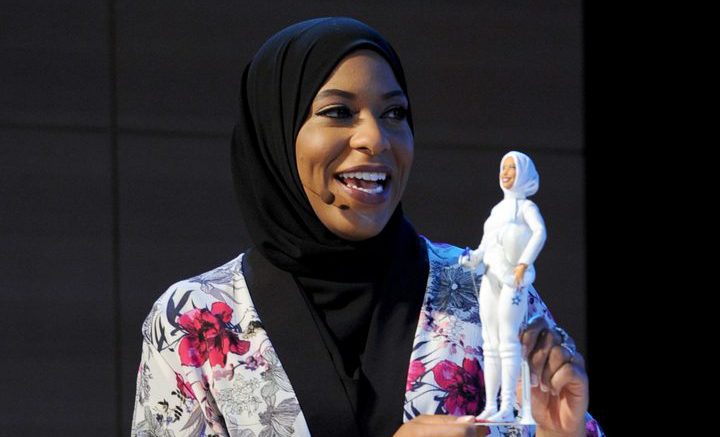I see that the toymaker Mattel is bringing out a Hijab Barbie doll based on the image of an American Muslim sportswoman. This company, one of the largest toy makers in the world based on revenue, decided that it would virtue signal using a doll wearing a symbol that has been widely criticised by counter-Islam thinkers as representing Islamic misogyny and oppression of women.
The new Barbie doll, moddled on US Olympic fencer Ibtihaj Muhammad is part of a sub range of the Barbie line based on women that the company has chosen because they believe are inspiring to girls. The line also includes a ballerina and a female film director.
Whilst I have no animosity to Ms Muhammad herself, who is an accomplished sportswoman, I do find myself questioning the wisdom of Mattel producing a doll that wears something that is often forced on Muslim women by Muslim men. It seems that in their efforts to virtue signal to the social justice warrior crowd and head off complaints from some feminists that the traditional Barbie encouraged girls to be passive, Mattel has helped to normalise this troubling garment. Now there are many religions that encourage head covering and there are paths within both Christianity and Judaism where either women or men or both, have head covering rules that vary in their degrees of strictness depending on the particular sect. Sometimes these head covering rules can be enforced by social pressure with people who don’t headcover ‘properly’ or in the socially accepted way, excluded from certain aspects of communal life or activity. However, the way that Muslim women in the Muslim world are forced into hijab often goes way beyond social exclusion or people just tutting about it and crosses the line into misogynistic violence.
Across the Islamic world women are forced, sometimes with violence or the threat of violence, into garments that are less to do with the idea of modesty and look more to do with the idea of a woman advertising her second class citizen status. In many Islamic societies a woman is not her own person, she is always the property or under the control of some man or other whether that be husband, brother, father or uncle. In some more strict Islamic societies there are official guardianship schemes which control women’s movements to a very significant degree. All women in these highly patriarchal and misogynistic Islamic societies are forced to wear garments, such as the Hijab, that at best say ‘I’m less than a man’ and at worst hide women away in mobile canvas prisons such as the Burkha and Niqab, denying them even the right to communicate with others using facial expressions. Sadly ‘the invisible woman’ is a fact of life in the Islamic world.
Despite Mattel’s inclusion of strong non Muslim women in its sub range of inspiring women, I wonder what message a Hijab Barbie sends to girls? Does putting out a doll wearing a garment linked to misogynistic oppression inspire girls to widen their horizons when it comes to career goals or does it normalise the Islamic culture of gyno-hatred from whence the Hijab and other restricting Islamic female garments come from? There are plenty of quality, high achieving and famous female athletes that Mattel could have chosen if it was their intention to inspire girls to take up and become proficient at sport. That they chose instead an athlete wearing a garment that women are often forced under threat of violence to wear, says a lot about how Mattel didn’t really think this one through properly. The company appears to have embarked on a policy of empty virtue signalling and pandering to an Islamic audience and by doing so have created something that is damaging to the idea that women have the right to make choices. Producing a Hijab Barbie is about as divorced from the idea of being supportive to the concept of women’s equality, as it would be if they produced a play set depicting a standard Barbie which was pregnant and chained to the kitchen sink.
This bit of virtue signalling by Mattel does make me wonder just how far down the road of cultural relativism they will go? Will their next effort be a Burkha Barbie or a battered wife Barbie or maybe, for the benefit of the Pakistani market, an acid attack victim Barbie? At least these would have the virtue of realistically representing the lives of Muslim women under the often tyrannical rule of Muslim men.
I don’t think that this doll was produced for any other reason than for Mattel to be able to say to the SJW’s and Leftist Feminists ‘look at us ain’t we diverse now’ and by doing so avert any criticism and bullying from these groups about the perceived sexism of their other Barbie products.
Unfortunately the message that this doll sends out to girls, especially girls in the Islamic world and from within Islamic culture, is that they should accept badges like the Hijab that signify both their lesser social status and lack of agency without complaint. We would quite rightly be shocked and disgusted if a toy company brought out a My Little Transatlantic Slave Ship Captain figure (complete with whips, chains and slave ship) because it would be seen to endorse slavery, a practise that the West expended much blood and treasure to wipe out. We should be equally disgusted at Mattel producing a doll that both embraces and promotes the idea that women need to be covered because they are the property of the men who own them.




